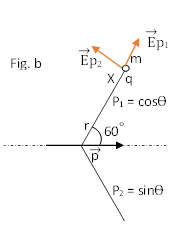
A point charge of charge q and mass m is placed at rest at point X at distance r from a short electric dipole. The initial acceleration of charge ${[ a=\dfrac{k\times q\times p}{2mr^3}n ]}$, where ${[ k=\dfrac{1}{4\pi\varepsilon_0} ]}$ then n is-
A. 6.4
B. 2.6
C. 5.0
D. 8.9
Answer
219.3k+ views
Hint:As we know the force is mass multiplied by acceleration but in the gravitational force the acceleration is acceleration due to gravity so acceleration does not depend on the mass and in electric force the acceleration depends on the mass. As we break the component P it breaks into component Ep1 and Ep2 axial and equatorial respectively.
Formula used:
${f=m\times a}$
${f=q\times\vec{E}}$
${\left|\vec{E}\right|=\sqrt{\left|\vec{E}p_1\right|^2+\left|\vec{Ep_2}\right|^2}}$
Complete answer:
As we know force is-
${f=m\times a}$
and, ${f=q\times\vec{E}}$
where, m = mass
a = acceleration
q = given charge
E = electric field
Now to find out the net electric field from the dipole first we need to divide p in two parts which is p1 and p2 whose values are cosϴ and sinϴ respectively.
p1 = cos ϴ
p2 = sin ϴ
These are the two components of our dipole equatorial and axial, equatorial position will be at the 180˚ of the p2 which is Ep2 and along the axis of p1 will be Ep1.
Now for equatorial position our electric field will be-
${{\vec{E}}_{(equatorial)}=\dfrac{pk}{r^3}}$
${Since,[ k=\dfrac{1}{4\pi\varepsilon_0} ]so,}$
${{\vec{E}}_{(equatorial)}=\dfrac{p}{r^3}\times\dfrac{1}{4\pi\varepsilon_0}}$
${{\vec{E}}_{p_2}=\dfrac{p}{r^3}\times\dfrac{1}{4\pi\varepsilon_0}}$
${{\vec{E}}_{(equatorial)}=\dfrac{p\ sin\theta}{r^3}\times\dfrac{1}{4\pi\varepsilon_0}}$
As we know that the angle ϴ is 60˚ so
${Sin\ 60˚ =32 }$
${{\vec{E}}_{(equatorial)}=\dfrac{p\ }{r^3}\times\dfrac{1}{4\pi\varepsilon_0}\times\dfrac{\sqrt3}{2}}$
Now for axial position our electric field will be-
${{\vec{E}}_{(axial)}=\dfrac{2pk}{r^3}}$
${Since, [ k=\dfrac{1}{4\pi\varepsilon_0} ] so,}$
${{\vec{E}}_{(equatorial)}=\dfrac{2p}{r^3}\times\dfrac{1}{4\pi\varepsilon_0}}$
${{\vec{E}}_{p_2}=\dfrac{2p}{r^3}\times\dfrac{1}{4\pi\varepsilon_0}}$
${{\vec{E}}_{(equatorial)}=\dfrac{2p\ cos\theta}{r^3}\times\dfrac{1}{4\pi\varepsilon_0}}$
As we know that the angle ϴ is 60˚ so
${cos\ 60˚ =12 }$
${{\vec{E}}_{(equatorial)}=\dfrac{2p\ }{r^3}\times\dfrac{1}{4\pi\varepsilon_0}\times\dfrac{1}{2}}$
${{\vec{E}}_{(equatorial)}=\dfrac{p\ }{r^3}\times\dfrac{1}{4\pi\varepsilon_0}}$
To determine magnitude of acceleration first we will determine with the help of magnitude of ${force-\left|\vec{f}\right|=m\times\left|\vec{a}\right| }$ -------(i)
${\left|\vec{f}\right|=q\times\left|\vec{E}\right|}$ -------(ii)
Equating both the equations of force (i) and (ii)
${m\times\left|\vec{a}\right|=q\times\left|\vec{E}\right| }$
${\left|\vec{a}\right|=\dfrac{q\times\left|\vec{E}\right|}{m} }$ ---------(iii)
Now magnitude of E will be,
${\left|\vec{E}\right|=\sqrt{\left|\vec{E}p_1\right|^2+\left|\vec{Ep_2}\right|^2}}$
${\left|\vec{E}\right|=\sqrt{\dfrac{p^2k^2}{r^6}+\dfrac{3}{4}\dfrac{p^2k^2}{r^6}}}$
${\left|\vec{E}\right|=\dfrac{pk}{r^3}\sqrt{1+\dfrac{3}{4}}}$
${\left|\vec{E}\right|=\dfrac{pk}{r^3}\sqrt{\dfrac{7}{4}}}$
${\left|\vec{E}\right|=\dfrac{pk}{2r^3}\sqrt7}$
Now, from equation (iii) putting value of mode E acceleration will be-
${\left|\vec{a}\right|=\dfrac{q\times p\times k}{2mr^3}\sqrt7 }$ --------(iv)
Now as given in question
${a=\dfrac{k\times q\times p}{2mr^3}n }$ -------(v)
Now equating both the equation (v) and(iv)
${\dfrac{k\times q\times p}{2mr^3}n=\dfrac{q\times p\times k}{2mr^3}\sqrt7}$
${n=\sqrt7}$
${n=2.645}$
Thus, the value of n is 2.6 and correct option is (B)
Note:Axial line is the line that passes through both the poles of the dipole the positive and the negative poles so basically it is through its axis, so it is called axial component and equatorial component is the component that is perpendicular to axial component.
Formula used:
${f=m\times a}$
${f=q\times\vec{E}}$
${\left|\vec{E}\right|=\sqrt{\left|\vec{E}p_1\right|^2+\left|\vec{Ep_2}\right|^2}}$
Complete answer:

As we know force is-
${f=m\times a}$
and, ${f=q\times\vec{E}}$
where, m = mass
a = acceleration
q = given charge
E = electric field
Now to find out the net electric field from the dipole first we need to divide p in two parts which is p1 and p2 whose values are cosϴ and sinϴ respectively.
p1 = cos ϴ
p2 = sin ϴ
These are the two components of our dipole equatorial and axial, equatorial position will be at the 180˚ of the p2 which is Ep2 and along the axis of p1 will be Ep1.
Now for equatorial position our electric field will be-

${{\vec{E}}_{(equatorial)}=\dfrac{pk}{r^3}}$
${Since,[ k=\dfrac{1}{4\pi\varepsilon_0} ]so,}$
${{\vec{E}}_{(equatorial)}=\dfrac{p}{r^3}\times\dfrac{1}{4\pi\varepsilon_0}}$
${{\vec{E}}_{p_2}=\dfrac{p}{r^3}\times\dfrac{1}{4\pi\varepsilon_0}}$
${{\vec{E}}_{(equatorial)}=\dfrac{p\ sin\theta}{r^3}\times\dfrac{1}{4\pi\varepsilon_0}}$
As we know that the angle ϴ is 60˚ so
${Sin\ 60˚ =32 }$
${{\vec{E}}_{(equatorial)}=\dfrac{p\ }{r^3}\times\dfrac{1}{4\pi\varepsilon_0}\times\dfrac{\sqrt3}{2}}$
Now for axial position our electric field will be-
${{\vec{E}}_{(axial)}=\dfrac{2pk}{r^3}}$
${Since, [ k=\dfrac{1}{4\pi\varepsilon_0} ] so,}$
${{\vec{E}}_{(equatorial)}=\dfrac{2p}{r^3}\times\dfrac{1}{4\pi\varepsilon_0}}$
${{\vec{E}}_{p_2}=\dfrac{2p}{r^3}\times\dfrac{1}{4\pi\varepsilon_0}}$
${{\vec{E}}_{(equatorial)}=\dfrac{2p\ cos\theta}{r^3}\times\dfrac{1}{4\pi\varepsilon_0}}$
As we know that the angle ϴ is 60˚ so
${cos\ 60˚ =12 }$
${{\vec{E}}_{(equatorial)}=\dfrac{2p\ }{r^3}\times\dfrac{1}{4\pi\varepsilon_0}\times\dfrac{1}{2}}$
${{\vec{E}}_{(equatorial)}=\dfrac{p\ }{r^3}\times\dfrac{1}{4\pi\varepsilon_0}}$
To determine magnitude of acceleration first we will determine with the help of magnitude of ${force-\left|\vec{f}\right|=m\times\left|\vec{a}\right| }$ -------(i)
${\left|\vec{f}\right|=q\times\left|\vec{E}\right|}$ -------(ii)
Equating both the equations of force (i) and (ii)
${m\times\left|\vec{a}\right|=q\times\left|\vec{E}\right| }$
${\left|\vec{a}\right|=\dfrac{q\times\left|\vec{E}\right|}{m} }$ ---------(iii)
Now magnitude of E will be,
${\left|\vec{E}\right|=\sqrt{\left|\vec{E}p_1\right|^2+\left|\vec{Ep_2}\right|^2}}$
${\left|\vec{E}\right|=\sqrt{\dfrac{p^2k^2}{r^6}+\dfrac{3}{4}\dfrac{p^2k^2}{r^6}}}$
${\left|\vec{E}\right|=\dfrac{pk}{r^3}\sqrt{1+\dfrac{3}{4}}}$
${\left|\vec{E}\right|=\dfrac{pk}{r^3}\sqrt{\dfrac{7}{4}}}$
${\left|\vec{E}\right|=\dfrac{pk}{2r^3}\sqrt7}$
Now, from equation (iii) putting value of mode E acceleration will be-
${\left|\vec{a}\right|=\dfrac{q\times p\times k}{2mr^3}\sqrt7 }$ --------(iv)
Now as given in question
${a=\dfrac{k\times q\times p}{2mr^3}n }$ -------(v)
Now equating both the equation (v) and(iv)
${\dfrac{k\times q\times p}{2mr^3}n=\dfrac{q\times p\times k}{2mr^3}\sqrt7}$
${n=\sqrt7}$
${n=2.645}$
Thus, the value of n is 2.6 and correct option is (B)
Note:Axial line is the line that passes through both the poles of the dipole the positive and the negative poles so basically it is through its axis, so it is called axial component and equatorial component is the component that is perpendicular to axial component.
Recently Updated Pages
Chemical Equation - Important Concepts and Tips for JEE

JEE Main 2022 (July 29th Shift 1) Chemistry Question Paper with Answer Key

Conduction Explained: Definition, Examples & Science for Students

Analytical Method of Vector Addition Explained Simply

Atomic Size - Important Concepts and Tips for JEE

JEE Main 2022 (June 29th Shift 1) Maths Question Paper with Answer Key

Trending doubts
JEE Main 2026: Application Form Open, Exam Dates, Syllabus, Eligibility & Question Papers

Understanding Uniform Acceleration in Physics

Derivation of Equation of Trajectory Explained for Students

Hybridisation in Chemistry – Concept, Types & Applications

Understanding the Angle of Deviation in a Prism

Understanding Collisions: Types and Examples for Students

Other Pages
JEE Advanced Marks vs Ranks 2025: Understanding Category-wise Qualifying Marks and Previous Year Cut-offs

Understanding Atomic Structure for Beginners

How to Convert a Galvanometer into an Ammeter or Voltmeter

Understanding Centrifugal Force in Physics

JEE Main Marking Scheme 2026- Paper-Wise Marks Distribution and Negative Marking Details

Degree of Dissociation: Meaning, Formula, Calculation & Uses




